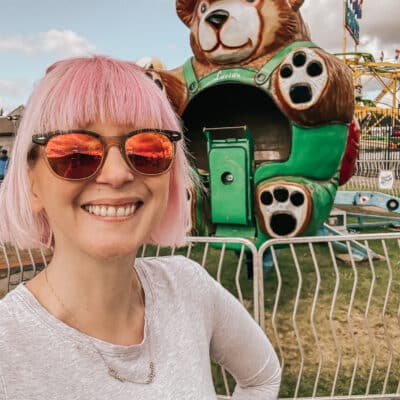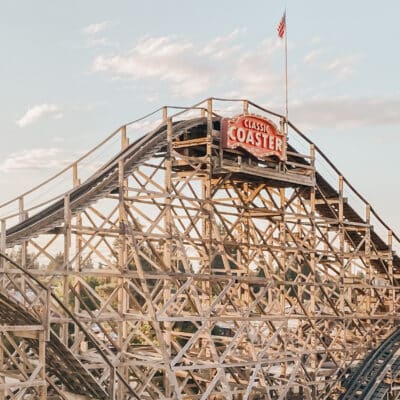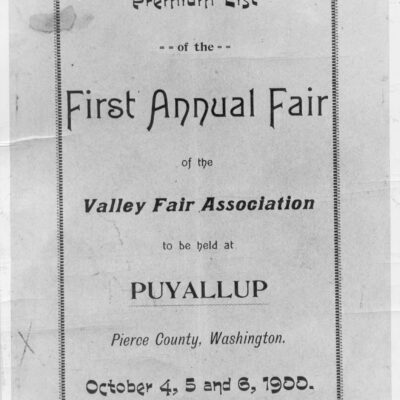Arts & Entertainment Community
Two In Tow & On The Go | Last weekend for the Puyallup fair

Me hangin’ with my giant bear buddies in SillyVille | 2024 photo by Tonya Strickland.
If the popular 1960s song, “(I Left My Heart) In San Francisco” was singer Tony Bennett’s signature piece, then “(I Left My Heart) at the California Mid-State Fair” could be mine.
Arts & Entertainment Sponsor
Arts & Entertainment stories are made possible in part by the Gig Harbor Film Festival, a proud sponsor of Gig Harbor Now.
Except, I don’t actually sing. But that’s beside the point because … well … aarg.
OK, so maybe my Tony Bennett analogy doesn’t make quite as much sense in print as it did in my head.
In any case, what I’m trying to say here is: state fairs have heart. And, they sure hold a special place in mine. From 2008 to 2015, I spent nearly a decade covering the California Mid-State Fair in Paso Robles for my old newspaper. I wrote about the cute local kids who performed the free stage shows, the mega-popular FFA and 4-H Junior Livestock Auction, and even the carnival vendor who faced fines for dispersing living, breathing, quarter-sized turtle babies to the winners of his ball-toss game. While I wasn’t a country-girl myself, reporting gave me an all-access (press) pass to the ways of ag life. And with it, the nostalgia of simpler times mixed into a whole lotta fun.
I got a glimpse of that again last week when I attended the Washington State Fair, which has just three days left in its 2024 run. That means this weekend is the perfect time for locals to catch all that fairground charm (minus the reptile contraband) before the music fades and the last funnel cake is served.
 Each year, more than a million people walk through the gates of the 165-acre Washington State Fair Events Center at 110 9th Avenue SW, in Puyallup in pursuit of good times. Spanning 20 days, kicking off Labor Day through most of September, the fair features hobby competitions, rides in two distinct carnival areas, food vendors galore, farm animals, 4-H and FFA animals, and even baby animals (can you tell we like animals?). Follow this link for the fair calendar and daily schedule through its final day on Sunday, Sept. 22.
Each year, more than a million people walk through the gates of the 165-acre Washington State Fair Events Center at 110 9th Avenue SW, in Puyallup in pursuit of good times. Spanning 20 days, kicking off Labor Day through most of September, the fair features hobby competitions, rides in two distinct carnival areas, food vendors galore, farm animals, 4-H and FFA animals, and even baby animals (can you tell we like animals?). Follow this link for the fair calendar and daily schedule through its final day on Sunday, Sept. 22.
Bowen and I try to get out the fair each fall with our friends from Seattle. Last week, we took the kids out of school for one day for a weekday fair experience without the crowds. Below, you’ll find a roundup of our favorite things to see, do and eat:
Home Arts
Handmade quilts, pies, tablescapes and more make the Home Arts exhibit in the Pavilion building an exhibition in classic fair culture and creativity. Organizers say the lighthearted competitions are a fairgoer favorite — and it sure is one of mine. Except, I had to drag my family up to see the items. But once they were there, looking at the crazy cool cake slices, canned jams, and colorful quilts — complete with their prize ribbons — the kiddos were captivated. Check the Home Arts schedule for info on the demonstrations and creative ideas on display.
Sillyville & ThrillVille
The carnival is massive at the Washington State Fair. Split into two general areas based on people’s age and height, rides and games are offered in SillyVille for little to big kids and in ThrillVille for bigger kids and adults. Clara, Wyatt and our friends’ kids darted between these sections for six hours, you guys. Per usual, we bought Dizzy Passes for the kids. Each pass includes unlimited rides in both sections plus two free carnival games – all at weekday or weekend/holiday price points. Attendants scan the a pass holder’s wristlet and then the rider is in! We got the Weekday Dizzy Pass for $55 per child, available online or on-site.
A Weekend Dizzy Pass is $65 per child and can only be purchased online, with limitations. The Extreme Scream drop ride costs 30 tickets and isn’t valid with the Dizzy Pass. You can download the fair’s mobile app for an interactive map of all ride locations.
Animals

Located just inside the Green Gate, the barn offers farm friends during the fair time and acts as a pretty stunning event venue the rest of the year.
Elsewhere, the Piglet Palace is another destination for major four-legged cuteness. Last week, it featured two tired mama pigs and their tiny nursing babies. Some of the piglets were black and white while others were pink and a peach-fuzz brown similar to a fawn. Regardless of color, they were all darling.

Carousel

Northwest Room at The Tacoma Public Library, (WSF_1960s-0160) | Bobby Stover, son of Fair employee Bill Stover, on the carousel in 1963.
We didn’t ride it this time, but even walking by the fair’s 1917 carousel is proof that it’s a beauty! Nowadays, I have a new appreciation for carousels after writing about this other local one and all the cool history these attractions have.
Fair organizers say Mr. Earl Douglas brought the first carousel to the fair on a horse-drawn wagon in 1923 where it entertained guests outside, right off the midway. Back then, its mangerie of ride-on animals was steam-powered and featured a Wurlitzer band organ (the same brand a Gig Harbor house has that our news team wrote about last year).
Today, the now-restored carousel has its own building at the fair – right next to the event center’s main entrance.
Food & The Indoor Food Court (yes, please)
- Bacon, beef and delicious … glazed donut buns?! Wyatt taking the biggest possible bite of his Donut Smash Burger from Extreme Carnival Eats at the indoor Fair Food Court building.
- Extreme Carnival Eats at the indoor Fair Food Court serves up the craziest creations like fried s’mores, donut burgers and funnel cake corn dogs.
- Extreme Carnival Eats has normal-ish stuff, too: Clara got the chicken strips and fries bucket.
I think everybody but Clara and I tried out the Donut Smash Burger (beef, bacon and donut buns) from the Extreme Carnival Eats vendor in the indoor Fair Food Court.

Kay’s Kitchen vendor, indoor Fair Food Court
Clara ate at the Extreme place, but I have a gluten allergy so I moseyed over to Kay’s Kitchen to find the cheeseburger advertised with an optional gluten-free bun. And yes! Their french fries also have a dedicated fryer, so no breaded chicken items are fried with my favorite skinny potatoes.
Having an indoor food court was a nice change to my own fair eating experiences of either sweating it out in the sun or dodging the rain.
Food Allergy Tip: The fair offers a special food allergies PDF so you can plan ahead.
Titled the Sensitive Selections Guide, fair visitors download or print a PDF list to find food vendors offering menu items for special dietary needs such as being gluten or dairy free.
Classic Coaster
The fair’s 1935 wooden roller coaster has a cool history exhibit in the overflow line.

Photo by Tonya Strickland
This permanent staple at the event center, now called the Classic Coaster, has had few other names according to this site:

Coaster Thrill Ride
Giant Coaster
Today: Classic Coaster
It also tells us that the Classic Coaster’s trains (the seats folks ride in) are named:
Ol’ Yeller
Blaz’n Blue
Or’nry Orange
A signed fixed to the fencing around the coaster gives a fascinating insight to its history. It reads:
“Edward H. Bollinger was a Swiss immigrant who built and operated a kiddie airplane ride and a 45-foot Ferris wheel in 1932 at the corner of Ninth Avenue SW and Fifth Street. When Bollinger built the (now-Classic Coaster) in 1935, (its) Douglas fir beams were fashioned by the Brew Manufacturing Plant on Pioneer Avenue, and brought to the grounds on horse-drawn wagons. A Model-A automobile was used for hoisting the beams into position.”
The roller coaster’s trains, which served as riders’ seats, also saw changes over the years, according to the signage. Designed by Frederick Church of Venice, California, the coaster’s original trains were boxy and later replaced with open seats used today. In 1950, (the coaster) was redesigned by Walker Leroy. A fire in 1970 destroyed a portion of the coaster, and it was rebuilt. The most recent major renovation took place from 2009 to 2013, and cost approximately $3.1 million.”

The 1935 Classic Coaster | 2024 photo by Tonya Strickland.
Yet to ride it
It’s so sad, but I have yet to ride this rollercoaster — and I really want to! But in visiting the fair with kids of varying heights, it hasn’t happened for us yet.
Speaking of the roller coaster area, another cool thing I saw last week was “Coaster Park,” a little pocket park that runs beneath the ride’s outer perimeter and is buffered from the hustle of the main carnival. Somehow it’s mostly quiet there, minus the rush of the roller coaster trains whooshing by. And, it looks like the cutest spot to sit and chill for a little bit when things feel too busy. It also has a semi-secret farm scene behind the fence!
More Fair history
Speaking of way back when, the fair’s history timeline, the annual event’s origin story goes something like this:
In June 1900, a group of local businessmen, farmers and residents planned the “Valley Fair” so farmers and ranchers could showcase their work in the Puyallup Valley area. The Valley Fair opened four months later in October on a vacant lot west of present-day Pioneer Park in downtown Puyallup. Admission was just $1 per family for all three days.

Northwest Room at The Tacoma Public Library, (WSF_1900s-0002.jpg); photo in the Public Domain.
The next year, in 1901, the fair opened in September and moved to a newly purchased 10-acre lot on 9th Avenue SW, where the group structured the fair around a racetrack. Horse racing remained a popular fair entertainment staple for the next 76 years before running its last horse in 1977. In the later years, the fair changed its name a few times and today is credited as the largest fair in the state.
Here’s a photo of the fair’s very first “Premium List/Book” – which is a guide that provides information for exhibitors, vendors, and event participants at the fair. Fun fact: the Washington State Fair still has one!
Want to enter one of several competitive exhibits in baking, art and hobbies? The modern Premium Book, only available online, will tell you all about how. Your next chance to enter is at the Washington State Fair’s next installment, the Spring Fair, planned for 2025 with specific dates to be announced.

Clara, Wyatt and I are joined by Patrick Blacketer of Seattle on the Wild Cat rollercoaster. His family is just outside the frame | 2024 photo by Tonya Strickland.
IF YOU GO:
Location:
Washington State Fair Events Center
110 9th Ave., SW, Puyallup
Admission:
• General (ages 13+): $15
• Child (ages 6 – 12): $12
• Seniors (ages 65+): $12
• Kids (ages 5 & under): FREE
﹊﹊﹊﹊﹊﹊﹊﹊﹊﹊﹊
See ya out there!

@two.n.tow
Tonya Strickland is a Gig Harbor mom-of-two and longtime journalist. Now in the travel and family niche, her blog, Two in Tow & On the Go, was named among the 10 Seattle-Area Instagram Accounts to Follow by ParentMap magazine. Tonya and her husband Bowen moved to Gig Harbor from California with their two kids, Clara (10) and Wyatt (8) in 2021. Find them on Facebook for all the kid-friendly places in and around town.










